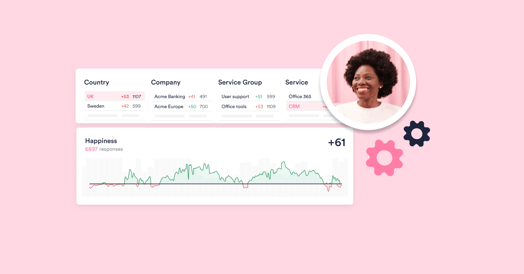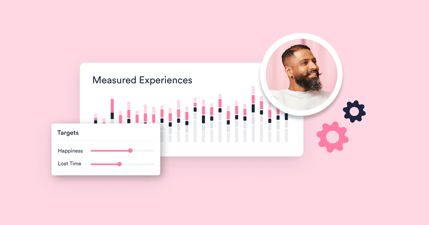Everyone loves IT service management (ITSM) trend lists. But what’s usually created (in these ITSM trends) lists has two “flaws” or issues. The first is that the lists can be focused at an ITSM level, potentially making them too abstract for IT support leaders and their teams to understand how the changes will impact the future of IT support. The second is that the trends are usually explained in isolation, without mentioning their interrelationships. You could also argue that there’s potentially another issue – that the lists are created based on the author’s opinion rather than data.
To help address these issues, this blog shares four IT support trends (or ITSM trends from an IT service desk perspective). It also links them together, particularly using experience data to highlight how adopting ITSM trends is helping or hindering business operations and outcomes and the people who deliver them. In terms of the potential third issue, the shared IT support trends are from the latest ITSM.tools research on the trends resonating most with ITSM practitioners.
IT support trend #1: Artificial intelligence (AI) and automation
Most IT service desks are under pressure – whether this is to better support employees and business operations, to be more efficient, or to reduce costs. It’s often called the drive to be “better, faster, cheaper.” It replaces the traditional IT support “doing more with less” improvement mantra. This is a crucial point to note with AI – IT service desks aren’t under pressure to implement AI technology. Instead, the pressure relates to them becoming “better, faster, cheaper,” with AI just one of the potential “ingredients” for improved IT support.
So, while ITSM trend lists might call out the key opportunities of AI for ITSM, and IT support in particular, such as:
- Automated ticket handling that leverages natural language processing (NLP) and machine learning
- Intelligent self-service, including chatbots (virtual agents), for end-users
- Virtual assistants for service desk agents
- Predictive insights into performance and improvement.
IT support leadership needs to appreciate the linkages of these AI opportunities with other IT support trends. For example, experience data and insight are needed to understand which AI opportunities will have the most significant positive impact on business operations and outcomes and the people who deliver them. It can also be used to understand the relative success of AI adoption. This can be assessed in value, not just experience, terms, and the improvement opportunity can be viewed in the context of the associated cost of each opportunity, too. Adopting AI in IT support also impacts enterprise service management, where the new IT support capabilities can be extended to other business functions (as explained below).
IT support trend #2: Experience improvement
From an IT support perspective, the focus on experience-related improvements can be called employee experience, customer experience, service or support experience, or something else. The name isn’t overly critical. However, how experience is measured and the benefits of the improvements are.
When considering experience improvement, IT support leadership will be confronted by two different experience management approaches – human-centric IT experience management (ITXM) and digital employee experience management (DEX). ITXM solutions employ human feedback as the primary sensor for understanding the end-user experience. While DEX tools use technology to monitor the IT infrastructure to measure the employee experience from the end-user perspective.
These two solution types might seem similar. However, key differences exist between their outputs and what can be achieved. More can be read on these differences in this blog. These differences impact the other IT support trends outlined here. For example, only the human-centric approach offers real end-user insights and the context required to understand what matters most for improvement prioritization. This applies to the adoption of AI. Or a DEX tool that monitors the IT infrastructure isn’t best placed to help other business functions, such as Human Resources (HR), understand and improve their service delivery and support experiences.
IT support trend #3: Value
For an organization to demonstrate or communicate its value, it must measure value. For an organization to improve value, it needs to be focused on value. For many organizations, this is where their issues (with value demonstration) lie, and even if an organization wants to focus on value, it will struggle without value-based metrics.
Sadly, an organization’s IT support metrics might not relate to what business stakeholders deem valuable. IT service desks might measure the wrong things in the wrong places because:
- There’s an efficiency bias – measuring “how many” and “how fast” (or the mechanics of IT support) rather than the outcomes or value created
- The metrics are a supply-side rather than demand-side view of what’s necessary for IT support success
- Success is measured at the point of IT support supply, not its consumption.
There’s also the relevance of reported IT support metrics to key stakeholders, including employees. For example, do employees care that the IT service desk met a target? Especially when their IT isn’t functioning as well as they need it to. As to what employees and senior leadership do care about, human-centric experience management data offers this insight. It’s an important link between the IT support trends.
IT support trend #4: Enterprise service management
An important point for IT support leadership to note about enterprise service management is that, while the name implies the extension of ITSM into other corporate business functions – such as the HR department, Finance, and Facilities – the reality is that what’s usually shared (with other business functions) relates to IT support activities and the enabling technology.
There are two key elements for IT support leadership to consider with enterprise service management. The first is that if IT service desk capabilities are being shared, they must be optimized before sharing. This can include using service management best practices, traditional and newer digital capabilities (such as AI), and a better understanding of what’s working and what isn’t from the employees’ perspective (achieved using experience data). The second is that the capabilities introduced to improve IT support can also be shared with other business functions through enterprise service management. This includes AI and experience management, with other business functions also likely tasked with communicating their business value better.
What do you think about these four IT support trends, their interrelationships, and the importance of experience data to the future of IT support?
Read about Trends Driving IT Experience Management by Sami Kallio (CEO, HappySignals) and Roy Atkinson (CEO and Principal Advisor, Clifton Butterfield LLC)




